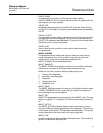
Reference Manual
00809-0400-4728, Rev AA
June 2011
3-13
Rosemount 644
Alarm Priority
Alarms are grouped into five levels of priority:
Status Options
Status Options (STATUS_OPTS) supported by the AI block are shown below:
Propagate Fault Forward
If the status from the sensor is Bad, Device failure or Bad, Sensor failure,
propagate it to OUT without generating an alarm. The use of these
sub-status in OUT is determined by this option. Through this option, the
user may determine whether alarming (sending of an alert) will be done by
the block or propagated downstream for alarming.
Uncertain if Limited
Set the output status of the Analog Input block to uncertain if the measured
or calculated value is limited.
BAD if Limited
Set the output status to Bad if the sensor is violating a high or low limit.
Uncertain if Man Mode
Set the output status of the Analog Input block to uncertain if the actual
mode of the block is Man.
NOTE
The instrument must be in Out of Service mode to set the status option.
Advanced Features
The AI Function Block provides added capability through the addition of the
following parameters:
ALARM_TYPE
ALARM_TYPE allows one or more of the process alarm conditions
detected by the AI function block to be used in setting its OUT_D
parameter.
OUT_D
OUT_D is the discrete output of the AI function block based on the
detection of process alarm condition(s). This parameter may be linked to
other function blocks that require a discrete input based on the detected
alarm condition.
Priority
Number
Priority Description
0 The alarm condition is not used.
1 An alarm condition with a priority of 1 is recognized by the system, but is not
reported to the operator.
2 An alarm condition with a priority of 2 is reported to the operator.
3-7 Alarm conditions of priority 3 to 7 are advisory alarms of increasing priority.
8-15 Alarm conditions of priority 8 to 15 are critical alarms of increasing priority.


















